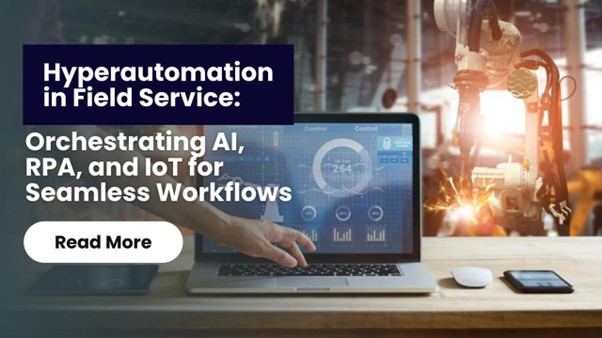Hyperautomation in Field Service: Orchestrating AI, RPA, and IoT for Seamless Workflows

Imagine that before anyone even realises there is a problem, a vital piece of equipment at a client location sends out an alert. An AI system evaluates the sensor data in a matter of seconds and identifies a probable issue. At the same time, a robotic process automation (RPA) bot automatically schedules the closest available technician with the necessary parts and skill set and produces a work order.
The client is notified that assistance is on its way when the technician’s mobile device pings with the assignment. All of this happens before the customer has time to dial a support number. It might sound futuristic, but such scenarios are becoming a reality with hyperautomation FSM strategies that blend AI, IoT, and field service RPA solutions into one intelligent workflow.
It’s a far cry from the old days of frantic calls and reactive dispatch. And it’s not just a tech fantasy – business leaders are taking notice. In fact, by 2024, a whopping 90% of large enterprises have already made hyperautomation a top priority. Field service organisations, in particular, are embracing this convergence of technologies to stay competitive. Innovators like FieldEZ – a leading provider of field service management solutions – are at the forefront of this shift, orchestrating AI-driven analytics, connected devices, and what some refer to as field service RPA2 (next-generation RPA tailored for field operations) to deliver seamless, automated service experiences.
What Exactly Is Hyperautomation in Field Service?
Conventional field service models frequently fall behind. According to a recent industry survey, 40% of organisations experience a persistent technician shortage, and 46% of organisations fail to satisfy customer SLAs. Clients are requesting real-time uptime and efficiency as they combine hard and soft services under a single IFM contract. However, providers continue to be reactive: only 33% of field service companies closely monitor downtime, compared to 55% of consumers.
In field service management (FSM), hyperautomation FSM brings together artificial intelligence (AI), machine learning, RPA bots, Internet of Things (IoT) sensors, and other tools under a unified strategy.
Technology | Field Service Role | Impact/Benefit |
AI | Predictive maintenance (analyzing IoT data) | Reduces downtime by up to 50% through early fault detectioni |
Intelligent scheduling & dispatch | Improves first-time fix rates by ~27% with optimized scheduling | |
AI-powered virtual assistants and chatbots | Enhances customer support and on-site diagnostics | |
RPA | Automate routine admin tasks (e.g. work orders, invoicing) | Cuts processing time drastically (e.g. ~60% per invoice) |
Integrate siloed systems (ERP, CRM) | Eliminates manual data entry errors and bottlenecks | |
Auto-fill reports and compliance logs | Frees technicians to focus on customer-facing work | |
IoT | Real-time asset monitoring (sensors on equipment) | Enables proactive fixes: up to 23% fewer emergency calls and significant lifespan gains. |
Condition-based alerts and automatic triggers | Increases first-time fix rates and asset uptime | |
Mobile connectivity enhancements (AR-guides, remote assistance) | Feeds AI models with live data for continuous optimisation |
For example, a traditional automation might be an RPA bot that copies inspection data from one system to another each night. In a hyperautomation scenario, that process becomes far smarter. An IoT sensor flags an anomaly in real time, AI algorithms assess the risk and decide if action is needed, and immediately an RPA routine kicks off the appropriate response (from scheduling maintenance to even ordering replacement parts).
Why the Push for Hyperautomation Now?
Increasing customer expectations, staffing difficulties, and demand to increase efficiency are all storms facing field service operations today. Corporate customers demand more proactive, integrated service delivery; in an effort to save expenses and streamline operations, many are combining several services under integrated contracts. Client expectations and service provider practices, however, frequently diverge. Hyperautomation is becoming essential for field service directors due to a number of convergent trends:
- Data Explosion & AI Readiness: 16 billion IoT devices were in use worldwide at the end of 2023, and by 2024, that figure is expected to increase to 18.8 billion. McKinsey reports that 72% of companies have already used AI into at least one area of their operations. Hyperautomation bridges the gap between these technologies by converting raw data into instantaneous decisions.
- Customer Expectations against Provider Deficits: 55% of customers track asset downtime, whereas just 33% of providers do so. This poses a problem. By aligning company KPIs with client objectives, hyperautomation bridges this gap.
- Constant-On Communication: Data from mobile, cloud, and IoT devices is integrated by FieldEZ and other modern FSM solutions, enabling intelligent, continuous operations that do not necessitate human participation.
- Labour Shortages & Cost Pressures: The skill gap grows when seasoned technicians retire. Hyperautomation increases worker productivity; field service automation users claim a 346% return on investment and a payback in less than six months.
Key Benefits of Embracing Hyperautomation FSM
In field service, hyperautomation is more than just a catchphrase; it actually improves operational KPIs, financial indicators, and customer pleasure. The most significant benefits listed below provide strong justification for C-suite executives considering such initiatives:
- Reduced Downtime: Predictive intelligence replaces reactive firefighting. AI and IoT detect issues before they escalate, cutting unplanned downtime by up to 50% (McKinsey). The result — fewer breakdowns, uninterrupted operations, and stronger customer confidence.
- Higher First-Time Fix Rates: Technicians arrive better prepared with AI-driven diagnostics and automated parts allocation. This precision reduces repeat visits by around 12%, saving time, travel costs, and customer frustration.
- Faster Service & Cash Cycles: Automation streamlines everything from scheduling to invoicing. Work orders close faster, data syncs instantly, and payments move sooner. A Forrester study found companies saved $2.8 million in interest simply by billing quickly through automated FSM systems.
- Superior Customer Experience: Hyperautomation creates proactive, transparent service — where clients get real-time updates and zero downtime. Businesses leading in customer experience grow 12% faster, and 64% of buyers now value experience over price. Consistency, speed, and trust become your new differentiators.
Challenges and Considerations in Implementing Hyperautomation
Despite its clear benefits, implementing hyperautomation in field service is not a plug-and-play endeavor. C-suite leaders must be mindful of several challenges and plan accordingly to truly reap the rewards:
Challenge | Impact | Strategic Solution |
Data Silos & Integration | Fragmented data weakens insights | Invest in API-led integration and centralized FSM platforms |
Change Resistance | Workforce fears “automation takeover” | Position automation as augmentation, not replacement; provide training |
Lack of KPIs | Hard to measure ROI | Define metrics: MTTR, CSAT, cost per job, uptime |
Scaling Across Units | Pockets of automation without cohesion | Establish an automation Center of Excellence |
Security & Governance | IoT & AI create new attack surfaces | Apply encryption, strong access control, and algorithm governance |
FieldEZ: Pioneering the Hyperautomation FSM Revolution
FieldEZ’s approach to hyperautomation goes beyond plugging in AI, RPA, or IoT as separate tools. It’s about weaving them together into one intelligent, living system — one that learns, anticipates, and acts almost instinctively. Picture this: a machine senses an issue, an AI diagnoses the problem, an RPA bot schedules the technician, and the customer gets notified — all before anyone even picks up the phone. That’s not a far-fetched future.
At the heart of FieldEZ’s innovation is its AI-driven dispatch engine, which analyzes technician skills, proximity, and job urgency to assign the right person to the right task — cutting downtime and improving first-time fix rates. Integrated RPA bots handle repetitive coordination, ticket verification, invoicing, and compliance logging, reducing manual effort and accelerating cash flow.
By connecting with IoT-enabled devices, FieldEZ will enable predictive, automated responses — turning machine alerts into instant work orders and proactive maintenance. Its consultative, modular approach ensures that hyperautomation is tailored, not templated.
For organisations adopting FieldEZ, the results are clear: faster responses, lower service costs, and heightened customer satisfaction. FieldEZ isn’t just implementing hyperautomation — it’s redefining how field service operates in the AI-driven era.
Conclusion: Building a Future-Ready Field Service Operation
Global spending on these technologies is set to skyrocket (forecast to surpass $220B by 2034), and 75% of executives today see automation as a decisive competitive advantage. For CxOs in field service, the message is clear: orchestrating AI, RPA, and IoT unlocks higher uptime, lower costs, and better customer experiences. Leaders who act now – using platforms like FieldEZ to automate end-to-end workflows – will outpace competitors and build truly resilient, data-driven service operations. The time to move from promise to practice is now.



